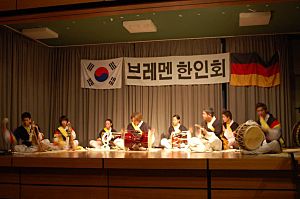Samul nori facts for kids
| Samul nori | |

A samul nori performance in Bremen, Germany
|
|
Quick facts for kids Korean name |
|
|---|---|
| Hangul |
사물놀이
|
| Hanja | |
| Revised Romanization | Samullori or Samul nori |
| McCune–Reischauer | Samullori or Samul nori |
Samul nori is an exciting traditional Korean musical performance. It uses four special percussion instruments. These instruments are the Jing, Janggu, Buk, and Kkwaenggwari. The performance often includes lively dancing too!
The name Samul nori has a cool meaning. In Korean, sa means "four," and mul means "object." Nori means "to play." So, Samul nori means "playing with four objects." It's a fun and energetic art form often shared in public.
Contents
What is Samul Nori?
Samul nori is all about the sounds of its four main instruments. Each one adds a unique beat and rhythm.
- The Jing is a large gong. It makes a deep, long-lasting sound.
- The Janggu is an hourglass-shaped drum. It can make many different sounds, from soft to loud.
- The Buk is a barrel drum. It provides a strong, low beat, like a heartbeat.
- The Kkwaenggwari is a small gong. It makes a sharp, high-pitched sound that leads the music.
These four instruments work together to create a rich and powerful sound. The performers also move and dance as they play. This makes the show even more exciting to watch.
A Bit of History
Long ago, Korean people often played Samul nori in the countryside. Farmers would play it after a long day of work. It was a way for them to relax and have fun. The music helped them feel refreshed and happy. It was a part of their daily life and celebrations.
Samul Nori Today
Today, Samul nori is still very popular. Many Korean musicians are working hard to keep this tradition alive. They want more people to know about and enjoy Samul nori.
Some famous Samul nori groups include Kim Duk Soo Samul Nori and Namsadang Nori. Namsadang Nori is so special that UNESCO recognized it. It was chosen as a Masterpiece of the Oral and Intangible Heritage of Humanity. This means it's a very important part of human culture.
Samul Nori Meets Modern Music
Some artists are mixing Samul nori with modern music styles. They combine the traditional sounds with new beats. For example, you might see Samul nori performers dancing with pop singers. They also perform with DJs in exciting new ways. This helps introduce Samul nori to a younger audience.
New Kinds of Performances
Samul nori has also inspired completely new types of shows. These performances use the idea of hitting objects to make music.
- Nanta is a famous show inspired by Samul nori. In Nanta, performers make music by hitting everyday objects. They use things like kitchen utensils and cutting boards. It's a very energetic and funny performance.
- Nori dan is another group inspired by Samul nori. They are a social enterprise in Korea. Nori dan plays music using recycled garbage as instruments. They show how even trash can make amazing sounds.
These new performances show how Samul nori continues to inspire creativity. It proves that traditional music can lead to fresh and exciting art forms.
See also
 In Spanish: Samulnori para niños
In Spanish: Samulnori para niños

